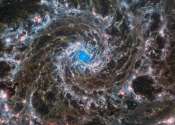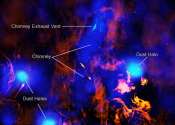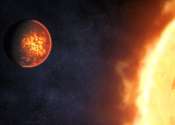Last update:
Astronomy & Space news

Second night of auroras seen 'extreme' solar storm
Auroras lit up skies across swaths of the planet for the second night in a row on Saturday, after already dazzling Earthlings from the United States to Tasmania to the Bahamas the day before.
Planetary Sciences
6 hours ago
0
12

Solar storm puts on brilliant light show across the globe, but no serious problems reported
A powerful solar storm put on an amazing skyward light show across the globe overnight but has caused what appeared to be only minor disruptions to the electric power grid, communications and satellite positioning systems.
Planetary Sciences
21 hours ago
0
40

AI may be to blame for our failure to make contact with alien civilizations
Artificial intelligence (AI) has progressed at an astounding pace over the last few years. Some scientists are now looking towards the development of artificial superintelligence (ASI)—a form of AI that would not only surpass ...
Astrobiology
May 11, 2024
13
286

The ancient Egyptian goddess of the sky: How a researcher used modern astronomy to explore her link with the Milky Way
What did our ancestors think when they looked up at the night sky? All cultures ascribed special meaning to the sun and the moon, but what about the pearly band of light and shadow we call the Milky Way?
Astronomy
May 11, 2024
0
68

Is dark matter's main rival theory dead? The Cassini spacecraft and other recent tests may invalidate MOND
One of the biggest mysteries in astrophysics today is that the forces in galaxies do not seem to add up. Galaxies rotate much faster than predicted by applying Newton's law of gravity to their visible matter, despite those ...
Astronomy
May 10, 2024
4
943

Astronomers are on the hunt for Dyson spheres
There's something poetic about humanity's attempt to detect other civilizations somewhere in the Milky Way's expanse. There's also something futile about it. But we're not going to stop. There's little doubt about that.
Astronomy
May 10, 2024
2
66

NASA's Chandra notices the galactic center is venting
Using NASA's Chandra X-ray Observatory, astronomers have located an exhaust vent attached to a "chimney" of hot gas blowing away from the center of the Milky Way galaxy. Their paper describing these results is published in ...
Astronomy
May 10, 2024
0
93

Astronomers propose a new stellar theory to explain the origin of phosphorus
Astronomers have proposed a new theory to explain the origin of phosphorus, one of the elements important for life on Earth. The theory suggests a type of stellar explosion known as "ONe novae" as a major source of phosphorus.
Astronomy
May 10, 2024
0
575

Study reveals mechanisms of hydrodynamic escape in low-mass exoplanets
A study published in Nature Astronomy and conducted by Guo Jianheng from the Yunnan Observatories of the Chinese Academy of Sciences offers a perspective on the violent atmospheric escape processes of low-mass exoplanets, ...
Planetary Sciences
May 10, 2024
0
10

An abundance of distant gas-rich galaxies found by FAST
Astronomers, using the Five-hundred-meter Aperture Spherical radio Telescope (FAST) in China's Guizhou Province, have found an abundance of gas-rich galaxies in the distant universe.
Astronomy
May 10, 2024
0
8

Hubble Space Telescope glimpses spiral galaxy UGC 9684
The celestial object showcased in this image from the NASA/ESA Hubble Space Telescope is the spiral galaxy UGC 9684, which lies around 240 million light-years from Earth in the constellation Boötes. This image shows an impressive ...
Astronomy
May 10, 2024
0
51

First 'extreme' solar storm in 20 years brings spectacular auroras
Earth was set to be struck by more powerful solar storms on Saturday, a day after the most extreme events in two decades triggered spectacular celestial light shows from Tasmania to Britain and threatened possible disruptions ...
Planetary Sciences
May 10, 2024
0
71

We need to consider conservation efforts on Mars, say researchers
Astrobiology is the field of science that studies the origins, evolution, distribution, and future of life in the universe. In practice, this means sending robotic missions beyond Earth to analyze the atmospheres, surfaces, ...
Astrobiology
May 10, 2024
0
34

Image: Bolivian salt lakes from orbit
This Copernicus Sentinel-2 image features salt flats and lakes in southwest Bolivia, near the crest of the Andes Mountains.
Planetary Sciences
May 10, 2024
0
19

Research investigates the environment of globular cluster NGC 6355
Using the Dark Energy Camera (DECam), Argentinian astronomers have investigated the environment of a galactic globular cluster known as NGC 6355. The study, presented in a paper published May 2 on the pre-print server arXiv, ...

TESS discovers a rocky planet that glows with molten lava as it's squeezed by its neighbors
UC Riverside astrophysicist Stephen Kane had to double-check his calculations. He wasn't sure the planet he was studying could be as extreme as it seemed.
Planetary Sciences
May 9, 2024
0
266

NASA images help explain eating habits of massive black hole
In images from NASA's retired Spitzer Space Telescope, streams of dust thousands of light-years long flow toward the supermassive black hole at the heart of the Andromeda galaxy. It turns out these streams can help explain ...
Astronomy
May 9, 2024
0
67

Looking for life on Enceladus: What questions should we ask?
Does life exist beyond Earth? One of the most compelling places to consider this possibility is Enceladus, a moon of Saturn with a liquid water ocean encased in a frozen shell. There, plumes of water spray from ice fractures ...
Astrobiology
May 9, 2024
1
186

Astrophysicists discover a novel method for hunting the first stars
A recent study led by the research group of Professor Jane Lixin Dai of the Department of Physics at The University of Hong Kong (HKU) has discovered a novel method for detecting the first-generations stars, known as Population ...
Astronomy
May 9, 2024
0
253

NASA watchdog report: 100+ cracks on heat shield biggest threat to human moon mission
The damage to the Orion capsule from the Artemis I mission is already top of mind for NASA as it works to make the Artemis II mission safe for humans. But a new agency report has revealed the extent of the problem, including ...
Space Exploration
May 9, 2024
0
15
More news

Q&A: AI in Earth observation—a force for good

Image: Sulaiman mountain haze

Exploring the asteroid Apophis with small satellites

White Sands propulsion team tests 3D-printed Orion engine component

SpaceX blasts off on 35th Space Coast launch of the year

Boeing Starliner crewed mission postponed shortly before launch
Other news

Study discovers cellular activity that hints recycling is in our DNA

Life expectancy study reveals longest and shortest-lived cats

GoT-ChA: New tool reveals how gene mutations affect cells

Boeing Starliner crewed mission postponed until at least Friday

Video: Using a hopping robot for asteroid exploration

Bilbies could hop back into mild climate zones, study finds

Researchers reveal new cellular mechanical transducer

Designer peptoids mimic nature's helices























































